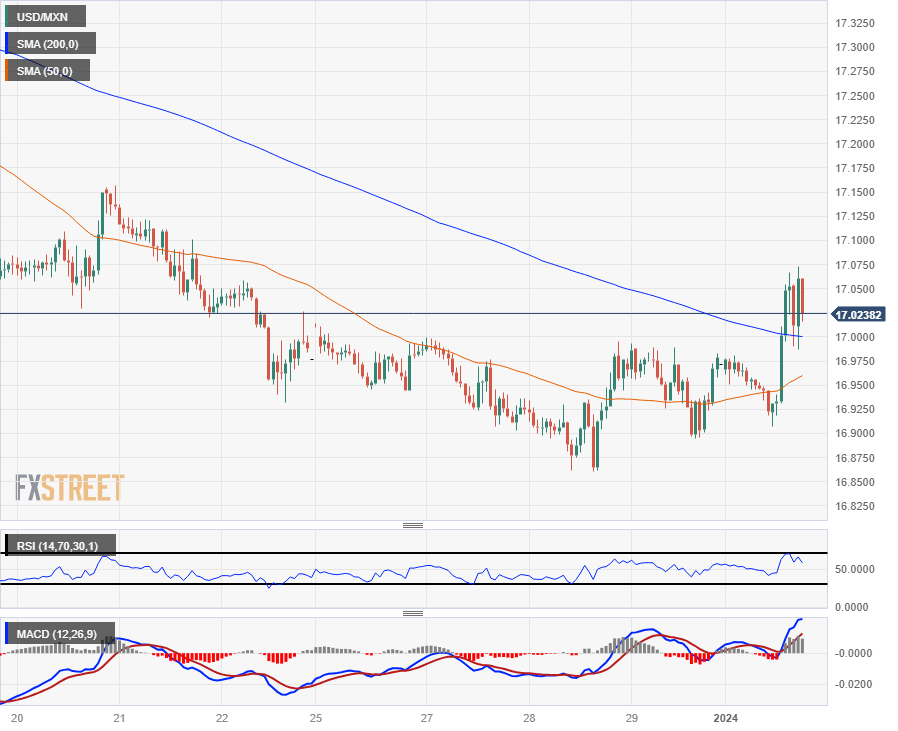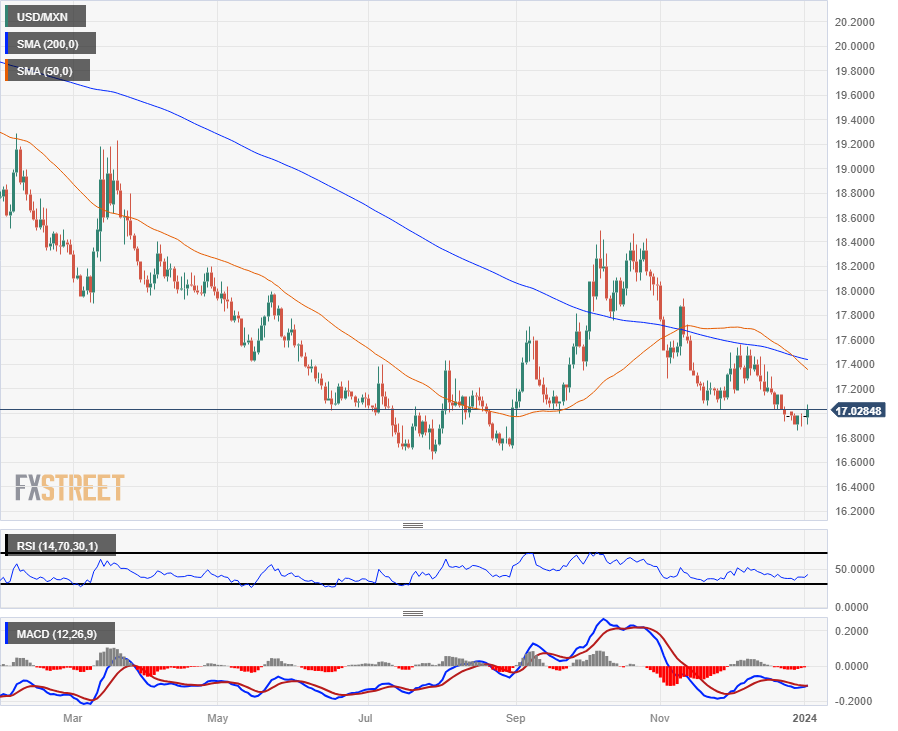- Phân tích
- Tin tức và các công cụ
- Tin tức thị trường
- Mexican Peso falls back to kick off the new trading year
Mexican Peso falls back to kick off the new trading year
- The Mexican Peso has slipped as broader markets focus on US data.
- Notable lack of Mexico data on the docket for this week.
- Markets are set to hinge on US labor, output figures ahead of NFP Friday.
The Mexican Peso (MXN) is taking a breather, retreating from a 17-week high against the US Dollar (USD) as markets kick off the new trading year focusing on US labor and output data.
Economic data from Mexico is absent from the calendar for this week, and the USD is set to be the primary driver to usher in 2024. The Greenback is rebounding in early trading as money markets ease back on bets of Federal Reserve (Fed) rate cuts, with the US Dollar reclaiming around a full percent against the Peso.
Daily digest market movers: Mexican Peso gives back recent gains as investors look to US NFP
- The US Dollar is climbing across the board to kick off the new year’s inaugural trading week.
- Money markets have eased back their bets of Fed rate cuts, still see up to 150 basis points in rate cuts through 2024.
- US output continues to fall, S&P Global Manufacturing Purchasing Managers’ Index (PMI) for December declined to 47.9, a four-month low. Median market forecast expected a steady print at November’s 48.2.
- US Construction Spending also missed the mark, slipping from October’s 1.2% (revised up from 0.6%) to print at 0.4% in November, missing the forecast of 0.5%.
- Wednesday brings the US ISM Manufacturing PMI, as well as the latest round of the Fed’s Meeting Minutes.
- Thursday sees the December print of the ADP Employment Change, but the figure has become notoriously inconsistent lately, poorly forecasting the release of Friday’s US Nonfarm Payrolls, alongside US Average Earnings and the ISM Services PMI.
US Dollar price this week
The table below shows the percentage change of US Dollar (USD) against listed major currencies this week. US Dollar was the strongest against the New Zealand Dollar.
| USD | EUR | GBP | CAD | AUD | JPY | NZD | CHF | |
| USD | 0.99% | 0.90% | 0.49% | 0.71% | 0.64% | 0.99% | 0.93% | |
| EUR | -0.84% | 0.08% | -0.35% | -0.12% | -0.36% | 0.16% | 0.04% | |
| GBP | -0.92% | -0.08% | -0.41% | -0.20% | -0.20% | 0.08% | -0.05% | |
| CAD | -0.49% | 0.32% | 0.59% | 0.21% | 0.13% | 0.49% | 0.39% | |
| AUD | -0.70% | 0.11% | 0.22% | -0.22% | -0.25% | 0.29% | 0.19% | |
| JPY | -0.63% | 0.37% | 0.33% | 0.05% | 0.26% | 0.52% | 0.19% | |
| NZD | -1.00% | -0.14% | -0.08% | -0.49% | -0.28% | -0.54% | -0.11% | |
| CHF | -0.87% | -0.02% | 0.06% | -0.35% | -0.15% | -0.24% | 0.13% |
The heat map shows percentage changes of major currencies against each other. The base currency is picked from the left column, while the quote currency is picked from the top row. For example, if you pick the Euro from the left column and move along the horizontal line to the Japanese Yen, the percentage change displayed in the box will represent EUR (base)/JPY (quote).
Technical Analysis: Mexican Peso fades top side, eases back as US Dollar rebounds
The Mexican Peso (MXN) is slipping back from near-term highs, getting pushed back down as market pivot into Greenback bets. The USD/MXN has rebounded above the 200-hour Simple Moving Average (SMA), climbing back over the 17.00 level following last week’s decline to a multi-month low of 16.86.
Bullish momentum in the US Dollar still faces a long climb upwards, with long-term technical resistance sitting at the bearish crossover of the 50-day and 200-day SMAs just south of 17.50. On the low side, a break below 2023’s lows of 16.62 will see the USD/MXN breaking into its lowest bids since 2016.
USD/MXN Hourly Chart

USD/MXN Daily Chart

Mexican Peso FAQs
What key factors drive the Mexican Peso?
The Mexican Peso (MXN) is the most traded currency among its Latin American peers. Its value is broadly determined by the performance of the Mexican economy, the country’s central bank’s policy, the amount of foreign investment in the country and even the levels of remittances sent by Mexicans who live abroad, particularly in the United States. Geopolitical trends can also move MXN: for example, the process of nearshoring – or the decision by some firms to relocate manufacturing capacity and supply chains closer to their home countries – is also seen as a catalyst for the Mexican currency as the country is considered a key manufacturing hub in the American continent. Another catalyst for MXN is Oil prices as Mexico is a key exporter of the commodity.
How do decisions of the Banxico impact the Mexican Peso?
The main objective of Mexico’s central bank, also known as Banxico, is to maintain inflation at low and stable levels (at or close to its target of 3%, the midpoint in a tolerance band of between 2% and 4%). To this end, the bank sets an appropriate level of interest rates. When inflation is too high, Banxico will attempt to tame it by raising interest rates, making it more expensive for households and businesses to borrow money, thus cooling demand and the overall economy. Higher interest rates are generally positive for the Mexican Peso (MXN) as they lead to higher yields, making the country a more attractive place for investors. On the contrary, lower interest rates tend to weaken MXN.
How does economic data influence the value of the Mexican Peso?
Macroeconomic data releases are key to assess the state of the economy and can have an impact on the Mexican Peso (MXN) valuation. A strong Mexican economy, based on high economic growth, low unemployment and high confidence is good for MXN. Not only does it attract more foreign investment but it may encourage the Bank of Mexico (Banxico) to increase interest rates, particularly if this strength comes together with elevated inflation. However, if economic data is weak, MXN is likely to depreciate.
How does broader risk sentiment impact the Mexican Peso?
As an emerging-market currency, the Mexican Peso (MXN) tends to strive during risk-on periods, or when investors perceive that broader market risks are low and thus are eager to engage with investments that carry a higher risk. Conversely, MXN tends to weaken at times of market turbulence or economic uncertainty as investors tend to sell higher-risk assets and flee to the more-stable safe havens.
© 2000-2024. Bản quyền Teletrade.
Trang web này được quản lý bởi Teletrade D.J. LLC 2351 LLC 2022 (Euro House, Richmond Hill Road, Kingstown, VC0100, St. Vincent and the Grenadines).
Thông tin trên trang web không phải là cơ sở để đưa ra quyết định đầu tư và chỉ được cung cấp cho mục đích làm quen.
Giao dịch trên thị trường tài chính (đặc biệt là giao dịch sử dụng các công cụ biên) mở ra những cơ hội lớn và tạo điều kiện cho các nhà đầu tư sẵn sàng mạo hiểm để thu lợi nhuận, tuy nhiên nó mang trong mình nguy cơ rủi ro khá cao. Chính vì vậy trước khi tiến hành giao dịch cần phải xem xét mọi mặt vấn đề chấp nhận tiến hành giao dịch cụ thể xét theo quan điểm của nguồn lực tài chính sẵn có và mức độ am hiểu thị trường tài chính.
Sử dụng thông tin: sử dụng toàn bộ hay riêng biệt các dữ liệu trên trang web của công ty TeleTrade như một nguồn cung cấp thông tin nhất định. Việc sử dụng tư liệu từ trang web cần kèm theo liên kết đến trang teletrade.vn. Việc tự động thu thập số liệu cũng như thông tin từ trang web TeleTrade đều không được phép.
Xin vui lòng liên hệ với pr@teletrade.global nếu có câu hỏi.















